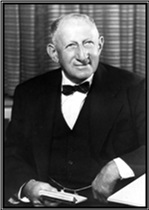Alfred A. Strauss, MD, FACS
Alfred A. Strauss, MD, FACS

In presenting the Annual Strauss Lectures, the Strauss/Friedlander family, is carrying on the tradition established so many years ago by Dr. and Mrs. Alfred
A. Strauss. Born in Germany in 1881, Dr. Strauss came to Colville, WA at the age of ten. An honor graduate of the University of Washington in 1904 and an outstanding member of the Alumni Association, he received the singular honor of the Alumnus Summa Laude Dignatus in 1951.
Dr. Strauss was a football star as an undergraduate. As an alumnus, he was active in the recruitment and establishment of scholarships for athletes at the University of Washington. He personally recruited more than 75 football players from the Chicago area, five of whom became college “All-Americans.” In 1981, he was elected to the Husky Hall of Fame.
He received his MD at Rush Medical College in 1908, graduating first in his class. He interned for two years at Michael Reese Hospital in Chicago and completed a brief period of study under Eugen Enderlen in Heidelberg, Germany. He then returned to Chicago, where he spent his entire medical career.
Dr. Strauss possessed a rare combination of skill, vision and drive, and was intimately involved with many “firsts” in the advance of medicine. In 1912, he devised a direct syringe-cannula technique to transfer warm blood from donor to recipient (Surg Gyn Obstet, Nov: 678-682, 1925). Subsequently, the method was applied extensively by physicians in the Army and Navy during World War II.
Dr. Strauss founded and organized the “Stomach Group” in 1914 at Michael Reese Hospital. This group, composed of specialists in various fields of medicine, surgery, psychology, and social work, was dedicated to the study of clinical and experimental problems related to the gastrointestinal tract, a multi-disciplinary approach that continues to gain popularity.
One of his first important publications, “An artificial ureter made from the abdominal wall,” (Surg Gyn Obstet, Jan.:78-84, 1914), was later clinically applied by Dr. L. I. McArthur. This technique was useful in saving kidneys in which the ureter was partially injured or destroyed.
In 1915, he authored a significant study, “New methods of pyloroplasty for congenital pyloric stenosis,” (JAMA, 65:1533-1537). From his earlier animal studies, he developed a method of extramucosal pyloroplasty and applied it to hundreds of infants, with negligible mortality. Since Fredet performed his first pyloroplasty in 1907 and Ramstedt performed his first in 1911, it is apparent that Dr. Strauss bridged the experience of these two after whom the operation is named.
In an unpublished paper given before the Chicago Surgical Society in 1915, Dr. Strauss advocated the use of subtotal gastrectomy for the surgical treatment of duodenal ulcer; he is probably the first in the United States to perform this procedure. By 1952 he reported a thirty-five year experience of surgically treating over 1500 of his ulcer patients (JAMA, 149:1095-1101), one of the largest series ever published on this subject. Later, a surgical method he had developed for treating a posterior penetrating duodenal ulcer was formally named “The Strauss Technique” (Surgery of the Stomach and Duodenum, 2nd Ed., Eds. Harkins H. and Nyhus, L., 1969).
His special interest in inflammatory bowel disease led to other major contributions. Maturation of an ileostomy and colostomy stoma by immediate mucocutaneous suture was highly touted in 1950 as a “new” concept. However, reference to a 1923 article by Dr. Strauss (Surg Clin NA, 3:1033-1042) establishes that years before, this was a standard procedure in his clinic. For those patients suffering from severe ulcerative colitis, he was an early advocate of total colectomy (Surg Clin NA, 4:667-686, 1924). Dr. Strauss has even been credited with inventing the first ileostomy bag (Ulcerative Colitis, by Bacon, H., 212-213, 1958).
According to R.L. Lawton (Contemp Surg 5:348-359, 1987), Dr. Strauss was the first to implant a zipper for abdominal wall closure. Clearly ahead of his time, in a 1936 article, he illustrated the use of a zipper sewn into the stomach and attached to the anterior abdominal wall, allowing easy access for the coagulation of gastric cancer (The Southern Surgeon 5:348-359). It was nearly half a century later before others published on zipper applications.
After the death of Dr. Strauss (in his 90th year), his influence continued. His book, Immunologic Resistance to Carcinoma Produced by Electrocoagulation, published in 1969, reviewed his fifty-seven years of experience treating carcinoma of the rectum by electrocoagulation. The Alfred and Hilda Strauss Oncology Center at Weiss Memorial Hospital in Chicago was dedicated in 1970 and is the culmination of his lifelong interest in cancer research and treatment.
Dr. Strauss and his two physician brothers (Herman and Siegfried), also University of Washington undergraduate alumni, founded Weiss Memorial Hospital (1953) in Chicago. Dr. Alfred Strauss is also well-remembered for his influence in founding the School of Medicine at the University of Washington (1946).
On July 22, 1944, Dr. Alfred Strauss, as a member of The Proposed Medical School Committee, met with Governor Langlie, strongly advocating for state funding for a new medical school. An appropriation bill was signed by the Governor on March 15, 1945. Soon after, in the fall of 1946, the first class started medical school. (Finch, Clement A.: Fulfilling the Dream – A History of The University of Washington School of Medicine 1946-1988, Heath Printers, pp 10-11, 30; 1990).
True to his continued interest in this institution, Dr. Strauss sponsored a surgical lectureship in 1950 for the Department of Surgery, and these lectures have been a prestigious annual event ever since. It is a pleasure to honor Dr. Strauss annual lectures.
